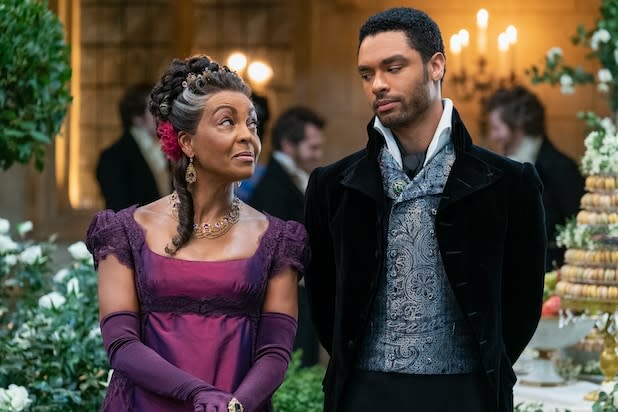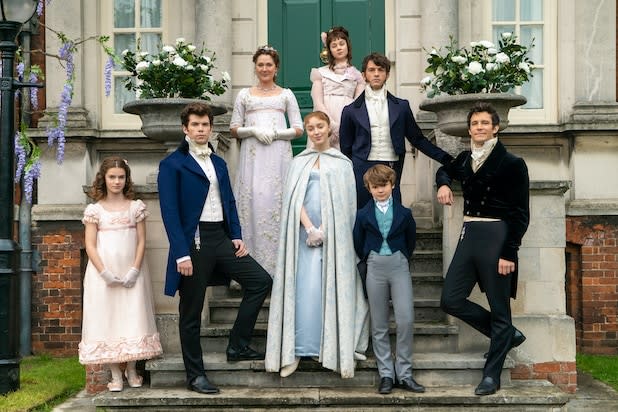Does ‘Bridgerton’ Have a Race Problem?
In the weeks since the Christmas Day release of “Bridgerton” on Netflix, critics have at turns praised the series for featuring Black characters in the predominantly white historical romance genre, and taken the show to task for how it handles those characters and the reality of racial dynamics in 19th-century London.
An adaptation of the beloved series of romance novels by author Julia Quinn, “Bridgerton” tells the story of Daphne Bridgerton (Phoebe Dynevor), the eldest daughter of the powerful Bridgerton family as she seeks a husband under the restrictive societal norms of the Regency era. She eventually finds love in Simon Bassett, the Duke of Hastings (Regé-Jean Page), London’s most eligible bachelor and, in the Netflix adaptation, a Black man.
As series creator Chris Van Dusen explained in an interview with TheWrap ahead of the show’s release, the decision to feature Black characters as English nobles stems from the theory held by some historians that Queen Charlotte was biracial in real life. It’s Charlotte (played by Golda Rosheuvel) in the show’s mythology who raised Simon’s family to noble status.
“I don’t call the casting color blind, because I feel like the word color blind implies that color and race was never considered — and I don’t think that’s true for ‘Bridgerton,'” Van Dusen said. “I think color and race is very much a part of the show and very much a part of the conversation, just like things like class and gender and sexuality are.
Also Read: 'Bridgerton': Here Are All the Modern Songs That Get Classical Covers

That intention toward onscreen diversity is present in all of Shonda Rhimes’ shows stretching as far back as the original cast of “Grey’s Anatomy,” which was praised for featuring multiple people of color as series regulars when it premiered in 2004. “Still Star-Crossed,” the Shondaland-produced “Romeo and Juliet” sequel series at ABC that aired in 2017, also brought in characters of color into a historically white genre, though in a more overtly “color-blind” fashion.
But throughout its eight-episode first season, “Bridgerton” walks the line between fantasy and reality. Classical string arrangements of Ariana Grande and Shawn Mendes singles mix with real historical figures and, more pointedly, references to slavery. Existing between those two worlds allows the show to bring its contemporary sensibility into an otherwise racist era.
Executive producer Betsy Beers explained the dichotomy to Entertainment Weekly by saying, “We try to imagine history and the world in the way we wanted to see it.”
Some critics, however, have called out “Bridgerton” for attempting to have its cake and eat it too. NPR critic Eric Deggans described the show as “ambivalent” on the matter of race, especially when compared to how it handles topics like class and gender.
Carolyn Hinds, in a heavily critical piece for The Observer, noted that the vast majority of the show’s speaking roles still go to white actors, and that “the characters’ race is practically ignored for almost the entire show, except for a few vague references in their dialogue — using words like ‘us’ and ‘them.'”
Also Read: 'Bridgerton' Showrunner Reveals Season 2 Plans and Lady Whistledown-Identity Easter Eggs

“Bridgerton” does go beyond vague references in its fourth episode, when Simon’s mentor, Lady Danbury (played by Adjoa Andoh), describes English society as “two separate societies divided by color.” That moment is one of only a few throughout the entire season in which race is explicitly addressed and — like the references to slavery — it’s one that complicates the progressive mentality the show attempts to project.
“You can’t say race isn’t of consequence when the world these characters inhabit was created in part through racism,” Hinds wrote. “Having Black people strolling around in the background doesn’t erase that, and it’s not enough. It means that the topic is relevant and should be addressed accordingly.”
In the New York Times, Salamishah Tillet called it a “strange” choice to only have Black characters discuss race, a decision that “risks reinforcing the very white privilege it seeks to undercut.”
In the concluding paragraphs of the piece, Tillet hoped for the show to move beyond “escapism” and spend more time in future seasons exploring the backstories of its Black characters, fulfilling the promise made by introducing those characters into Quinn’s story.
“Maybe if I knew how Lady Danbury or Queen Charlotte came to be, I’d be so convinced that I’d finally be able to revel in a past that I haven’t quite seen myself in before,” she wrote.

Read original story Does ‘Bridgerton’ Have a Race Problem? At TheWrap